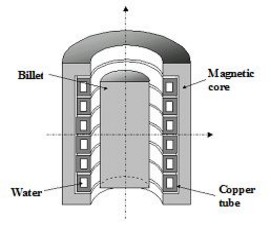2D example: Induction heating tutorial
Foreword
This paragraph is a summary of cases treated in detail in the 2D example: "Induction heating tutorial".
Study carried out
The study proposed in the “2D Induction heating tutorial” is the study of the induction heating of a steel billet.
Studied device
The studied device, shown in the figure below, contains the following components:
- an inductor that generates the source field: the inductor is a coil containing 6 copper tubes, supplied by a sinusoidal voltage source
- a charge corresponding to the heated component: a cylindrical steel billet
-
a magnetic core for magnetic flux shunting (flux concentrator)

Treated cases
The simulations depicted in the tutorial are presented as four case studies:
- case 1: study about the influence of the frequency and voltage supply values on the electric parameters of the device
- case 2: study of the induction heating of the billet with simplifying hypotheses
- case 3: study of billet induction heating without simplifying hypotheses
- case 4: study of the billet cooling after induction heating
Case 1
The first case is a steady state AC magnetic application for the study of the electric characteristics of the device:
It is about a parametric analysis of the power and current with respect to the inductor terminals for different values of the frequency and voltage supply.
Case 2
The second case is a steady state AC magnetic coupled with transient thermal application for the study of the induction heating process of the billet:
It is about a study carried out with the following simplifying hypotheses:
- non linear approximation for the B(H) characteristic of the magnetic materials;
- material properties independent on temperature
Case 3
The third case is a steady state AC magnetic coupled with transient thermal application for the study of the induction heating process of the billet:
It is about a study carried out without the previous simplifying hypotheses, i.e.:
- nonlinear B(H) characteristic for the magnetic materials;
- material properties dependent on temperature
Case 4
The fourth case is a thermal transient application studying the cooling process of the billet after the induction heating process corresponding to Case 3